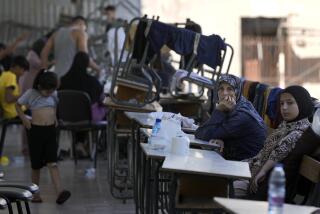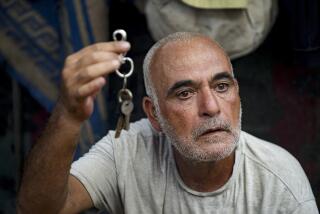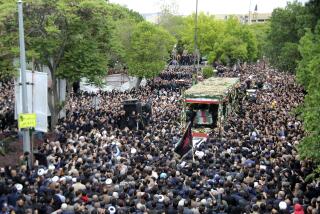Survivors Scarred by Iran Quake
CHANGOUREH, Iran — From atop a pile of rubble that buried Dr. Achbar Esmaeli alive, Jamsheed Amiri pointed to a deep black scar cutting across a hill in the distance. That’s the spot where the earth tore open and flames shot out the morning a powerful earthquake devastated this roughly 300-year-old village, he said.
Almost every home was destroyed, every family left to grieve the death of a loved one. The losses were so far-reaching that it is almost impossible to fathom how this village will get on; how it will rebuild, physically and emotionally.
The people walk up and down the dusty lanes, cleared out by bulldozers, and stop to pick through the rubble of last month’s quake, searching for a relic of a life that was buried: a shirt, a picture, an old rug.
“My mother-in-law, my sister, my aunt,” said Amiri, 60, listing his dead family members.
“My mother-in-law and my son,” said Tammam Majadi, 40.
“My mother, my father, my two sisters and my niece,” said Hassan Suleiman, 25.
“My mother, uncle, brother, nine people,” said Mohammed Shanbeluha, 32.
Everyone had the same numbing list and the same vacant expression of disbelief.
The earthquake struck this sparsely populated northwestern farming region June 22. It was 7:28 in the morning, and most of the men had gone out to the fields to work. Women, children and the elderly were home. The quake had a magnitude of 6.3 and cut a path of destruction through more than 100 villages scattered over the barren hills and golden fields that stretch for hundreds of miles west from the capital, Tehran. Officially, 235 people died, 1,300 were injured and as many as 25,000 were left homeless.
Ninety-three people died here.
“Our life has been destroyed,” said Hossein Mohammed Aliha, 53. “We lost everything. My wife and two sons.”
These are poor people whose families have lived here for generations; most residents are related by blood to one another. They work in the fields, growing barley, grapes and other grains and fruits. Their hands are callused and their faces wrinkled and leathery from the sun.
For the most part, they build their homes out of mud and straw. They have no choice, they say, because they cannot afford other materials.
When Shah Mohammed Reza Pahlavi ruled the country, many people bristled at the great disparity between the haves and have-nots. Then came the 1979 Islamic Revolution and the promise that there would be a redistribution of wealth. For these villagers, that eventually meant the arrival of electricity and phone service. But no one could say why the progress stopped there, whether it was the cost of the 1980-88 war with Iraq or Iran’s international pariah status from trying to export revolutionary ideas to other countries.
But the mud homes remained, even as experts warned that Iran sits on one of the Earth’s most seismically active zones and that no one should be sleeping beneath a ceiling made of mud and sticks. The structures were primitive, though elaborate, often with many rooms and arched doorways. One could easily carve a hole through a wall with a coin.
Now the government is talking about putting up steel-and-brick homes for everyone. Private companies are traveling through the region, taking surveys, drawing up plans for rebuilding. Local officials said the government has promised it will come to this village, at least, to build homes for everyone.
But the new dwellings will only be large enough for a few people; if locals want to expand, they will have to do so on their own. And they’ll probably use the materials they can afford: mud and straw.
“After the earthquake, the authorities told us we should change the style of building to steel and brick,” said Mohammed Eftekhari, 56, a resident of the nearby village of Tablashgin, where all 90 families were left homeless but no one was killed. “We have only a few sheep and cows, nothing more. If they are not going to help us, we will have to build out of mud and straw again.”
In Changoureh, residents are angry--and skeptical about their government’s concern. When Interior Minister Abdul Vahed Musavi-Lari visited the day after the quake, people jeered at him and threw rocks.
There was a lot of confusion in the immediate aftermath of the quake, and people are hard-pressed now to recall exactly what happened when.
But many in this village insist that if the government had responded faster with rescue efforts, more people would have lived.
It is difficult to determine whether this is a legitimate grievance or a natural desire to blame someone for something that seems beyond unfair. But there is a lot of second-guessing.
“You could hear voices under the rubble until 11 [a.m.], but we didn’t receive help and they died,” Majadi said. “My mother-in-law was washing dishes. My son was asleep.”
Mohammed Asgeri, 36, said goodbye to his family the Friday before the quake and headed into Tehran for his job as a driver. His 71-year-old father, Karam Ali, lived with the family and helped look out for Asgeri’s wife, Shalo, 33; son Mortazar, 13; and daughters Mahsa, 11; Mojgan, 9; and Zahra, 6.
The next morning, the quake struck. Neighbors managed to pull Zahra out of the rubble. They told Asgeri that his other children were alive for hours--until aftershocks came, and then they fell silent.
Asgeri and his daughter now live in a small white tent, one of 150 pitched by the Red Crescent Society. The tents are lined up in rows beneath the searing midday sun. At night, when temperatures drop, they provide little protection against the cold.
Besides the weather, there is too much idle time. For Asgeri that means nothing to do but look after his daughter and stare at the small color photo he has of his entire family, standing in the grass, smiling. He shows it to anyone who will look.
The government has promised to send bulldozers Monday to clear away the mountains of debris and begin the slow process of rebuilding. A few families rushed to salvage what they could from the ruins, but others wandered around as if still in a trance.
“It is very hard to get up from bed,” said Aliha, whose sons were 15 and 25 when they were crushed in their beds. “We have cried so much now we are out of tears.”
More to Read
Sign up for Essential California
The most important California stories and recommendations in your inbox every morning.
You may occasionally receive promotional content from the Los Angeles Times.










